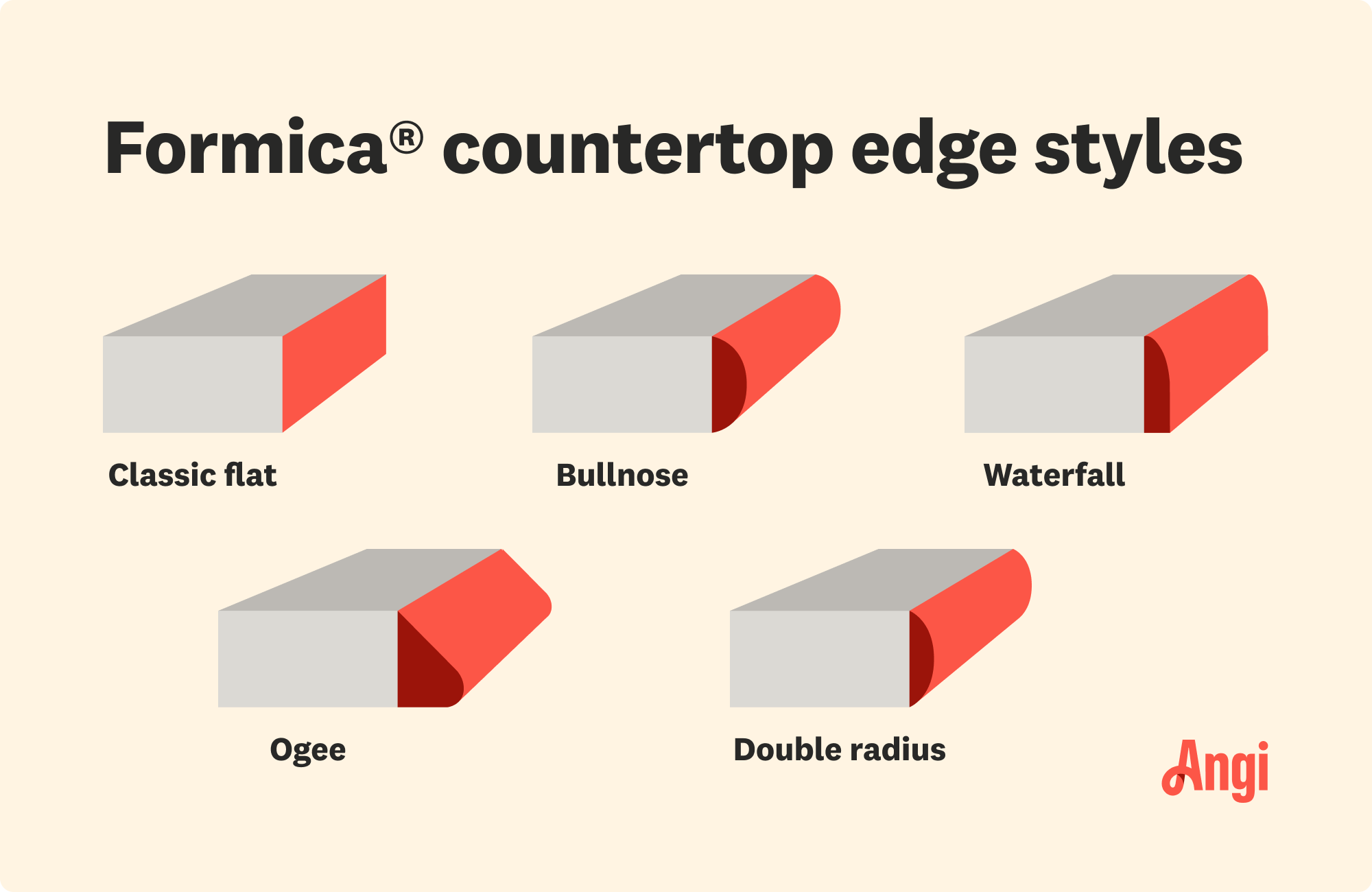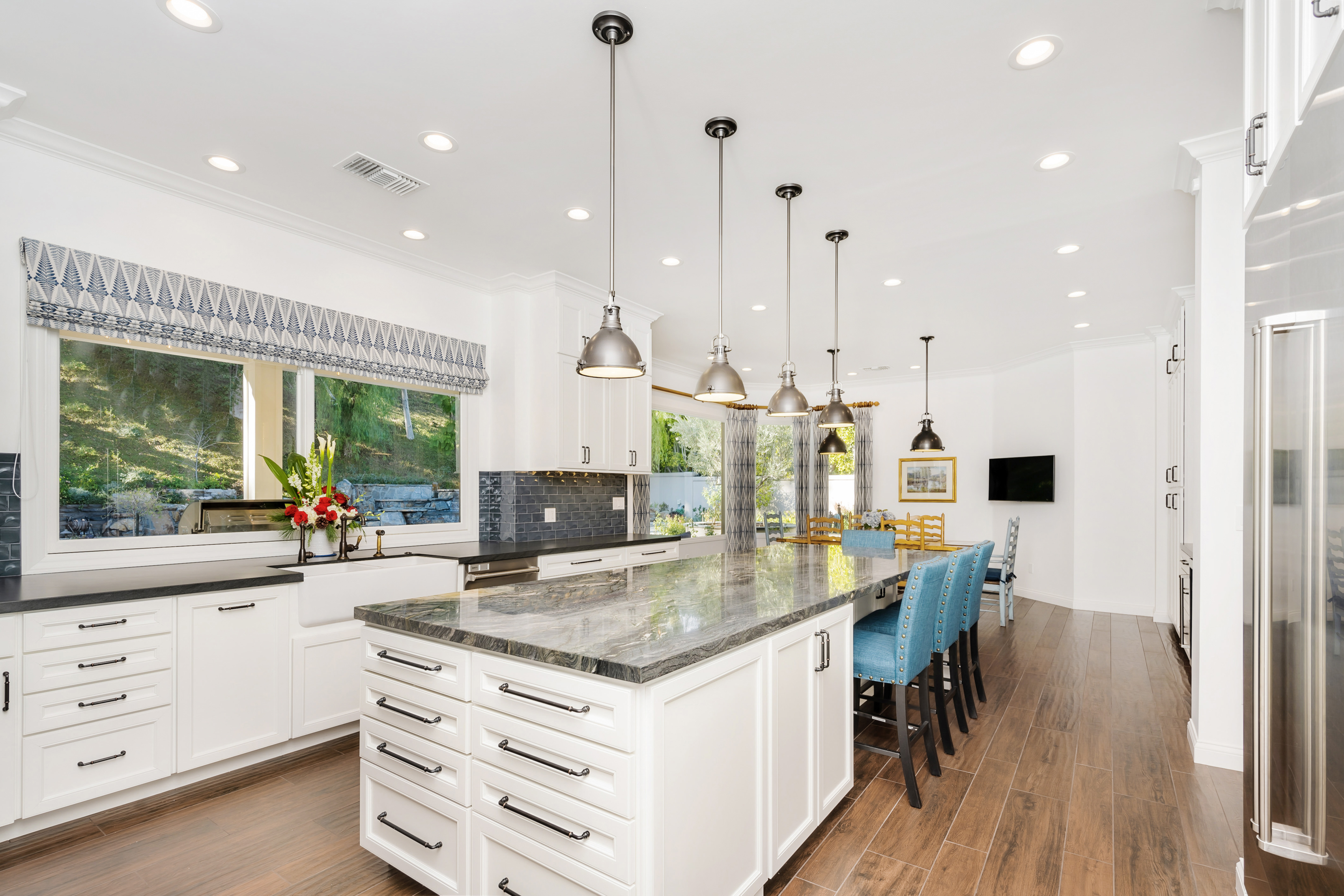
Explore how much concrete countertops cost to install based on factors like their size, thickness, location, finish, and labor rates.
Does the brand name differ from its off-brand competitors?


Laminate consists of layers of paper and resin on a particleboard base.
Formica is a popular brand of laminate.
It costs $10 to $80 per square foot to install laminate countertops, depending on the brand and quality.
Laminate is popular because it’s budget-friendly and aesthetically versatile.
The downside of laminate is that it’s prone to scratches and heat damage.
Formica is one of the most popular types of countertops in the United States—but what you might not know is that Formica is a popular brand of laminate. Are there significant differences between Formica and other laminates on the market? Let’s weigh the pros and cons.
Formica countertops have been around for decades and were particularly popular during the 1950s, 1960s, and 1970s. Their appeal endures today because of their affordability and the fantastic range of colors and patterns available, from abstract shapes to organic-inspired designs.
The actual surface is a resin-soaked material, usually kraft paper, that is adhered together in a high-heat process. In some instances, it is attached to particleboard or plywood. While laminate is not as durable as stone, it is easy to clean and resistant to stains.
When taking on this project, expect questions only a pro can answer. With our network of local pros, you'll get the job done and your questions answered—without the hassle and stress of doing it yourself.

Formica countertops typically cost between $40 to $80 per square foot, installed. They’re popular because they’re affordable, easy to install and clean, and have an almost limitless number of options. Though it’s not as trendy as other countertop types, it’s a reliable standard. The only drawback is that Formica isn’t as durable as other countertops. It’s only heat resistant up to 275 degrees Fahrenheit for a short period of time, and it’s prone to scratches.
| Pros | Cons |
|---|---|
| Stain and impact resistant | Prone to scratches |
| Heat resistant (up to 275 degrees Fahrenheit) | Only heat resistant for a short period |
| Fully customizable with hundreds of aesthetic options | Premium options are more expensive than other laminate brands |
| Easy to install | Difficult to repair |
| Believable stone, granite, quartz, and wood imitations | Moisture can cause delamination (especially at the seams) |
We know that Formica is a brand of laminate, but what actually is laminate? The laminate-making process involves gluing resin-soaked kraft paper onto a particle board base. A layer of decorative paper or foil makes up the finish, and another layer of resin—or transparent paper and resin if your laminate is patterned—provides protection. The result is a lightweight but durable surface material with a huge range of aesthetic versatility.

Homeowners love laminate countertops because they’re simple to install and budget-friendly—even if you hire a local laminate countertop installer. The main drawback is that quality can significantly vary from brand to brand; some are more heat and scratch resistant than others. Laminate is also highly susceptible to moisture damage, which can cause delamination along the seams. Here are some of the most common pros and cons of laminate countertops.
| Pros | Cons |
|---|---|
| Stain and impact resistant | Susceptible to heat damage and prone to scratches |
| Budget-friendly | Different brands can have a dramatic variation in quality |
| Easy to clean | Moisture can cause delamination (especially at the seams) |
| Easy to install | Difficult to repair |
| Hundreds of aesthetic options | Stone, granite, quartz, and other imitation options may look fake |

In the battle of laminate vs. Formica countertops, there’s no clear winner. Formica may have a higher standard of quality than off-brand imitations, but there are other quality brands on the market like WilsonArt or Arborite. Here’s how Formica performs compared to your average laminate.
Homeowners often choose laminate as a wallet-friendly alternative to other countertop types, so you’ll find designs that imitate natural stones and other materials. Though some brands have near-identical replicas, others can look fake (think: marble that looks painted and weirdly symmetrical granite). The main giveaway of low-quality laminate is brown edges. Formica offers an IdealEdge option that hides the edge seam, making it look like a quartz or solid surface countertop.
Laminate happens to be one of the most versatile types of countertops on the market. Designs replicate everything from quartz, marble, granite, and wood to decorative patterns and bold colors. You can even get different textures and finishes—but Formica takes it a step further.
Formica Envision allows you to create any laminate design using your own art, photos, and illustrations. The only limit is your imagination. Most brands don’t have a custom design studio, though WilsonArt is a close competitor.
Durability is where brand name matters. Laminate has come a long way since the 1950s, but it’s still susceptible to scratches and delamination if moisture seeps into cracks and seams. It’s also particularly vulnerable to heat damage. Even something as seemingly harmless as a coffee cup can leave a ring. However, Formica is rated to withstand temperatures up to 275 degrees Fahrenheit for a short time.
Laminate is one of the most affordable countertops. For most homeowners, the cost of laminate countertops is between $10 and $40 per square foot, excluding installation. Formica is slightly more expensive than other brands, at a minimum of $15 per square foot, or around $25 per square foot on average. Premium designs, edging, and finishes will raise the overall cost.
Compared to other countertop types, laminate is easy to install because it’s lightweight. Many homeowners choose to DIY their laminate countertops. Keep in mind there is a risk that laminate will crack when you cut it with a circular saw. You’ll also need to seal seams and joints properly to keep moisture out. A countertop installer in your area will know how to avoid those issues.
Laminate is prone to damage, and it’s not easy to repair. The best way to fix scratches in a laminate countertop is with a laminate paste or resin paint, but this is easier said than done if your laminate is patterned.
Unfortunately, damage to laminate counters is often irreparable, especially water damage. Laminate will warp if water reaches the particleboard below. You’ll likely need to replace that section of the countertop entirely.
Laminate is stain resistant, so it’s easy to maintain. You just have to wipe it clean (with soapy water and a mild bleach solution) and avoid heat damage and scratches that require repairs. Formica offers an antimicrobial line of laminate that repels the type of microbes that cause stains and odors (though you’ll still need to use disinfectant if you want to eliminate viruses).
Laminate countertops last 10 to 20 years with standard use. High-quality brands like Formica will last longer than inexpensive off-brands, but it depends on whether you meticulously avoid the type of damage that warps laminate. To extend the lifespan of your laminate countertops, clean water spills and splashes as soon as they happen, and use trivets and placemats.
Laminate countertops won’t take value away from your home, but they won’t add to it either. They’re typically the baseline standard for countertops rather than an upgraded feature like granite or stainless steel. Even a high-end brand of laminate like Formica won’t make a difference. What’s most important is that the countertop appeals to buyers

Homeowners can expect their average countertop installation cost to be around $3,140. This average encompasses a wide range of countertop materials, from stone to laminate. What you will pay depends on the size of your space and the labor cost in your area or region.
However, the average cost of laminate countertops is significantly lower for those seeking a budget-friendly option. With costs per square foot starting at $10, homeowners can expect their costs to be sliced by more than half, averaging $1,250.
For experienced DIYers, laminate countertops are one of the easier countertop materials to work with than most wood and concrete types. However, the project involves precise measuring, cutting, and building skills to create a flawless result, especially when working around sinks.
Mistakes can lead to uneven surfaces, peeling, or costly damage that outweighs the initial savings of DIYing and can affect the longevity of your countertop. Hiring a professional countertop installer guarantees the best outcome if you are looking for expert results. Pros have the tools and expertise to handle tricky corners, seams, and cuts, which makes all the difference in appearance and durability over time.
From average costs to expert advice, get all the answers you need to get your job done.

Explore how much concrete countertops cost to install based on factors like their size, thickness, location, finish, and labor rates.

Granite counters are durable and stylish, but if you’re wondering how much granite countertops cost, it’s time to dig into the details.

Are you leaning towards solid surface countertops? If so, you've likely come across Corian®. Find out how much Corian® countertops cost so you can plan your project.

Depending on the type of damage, you can repair a laminate countertop yourself—here are some tips to help restore your countertop.

How much does granite weigh? Estimate the weight of granite countertops for any size and thickness with our quick and accurate calculator tool.

Cutting your own countertops? This guide is for you. Learn how to cut laminate, butcher block, stone, and Formica.